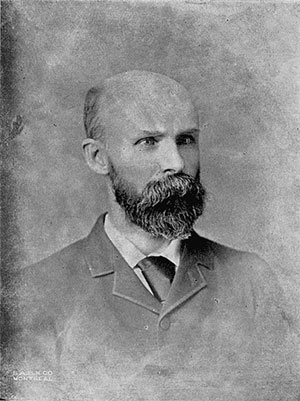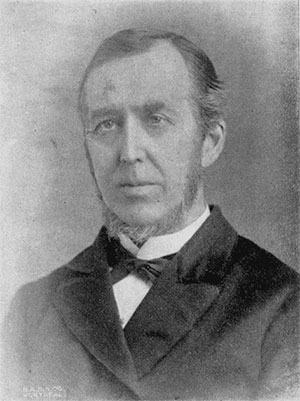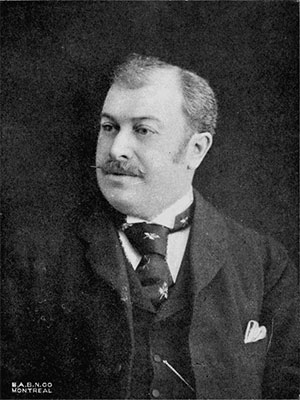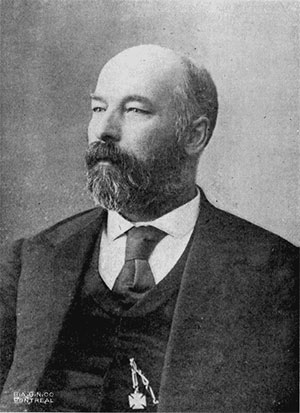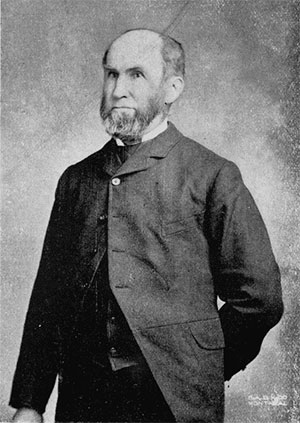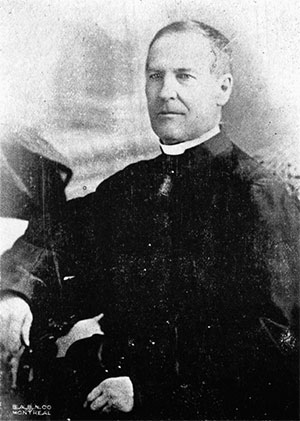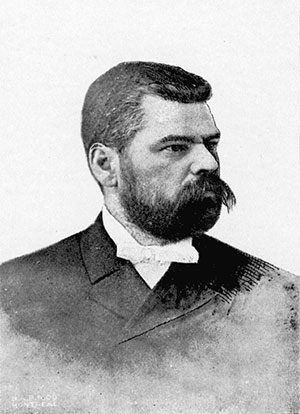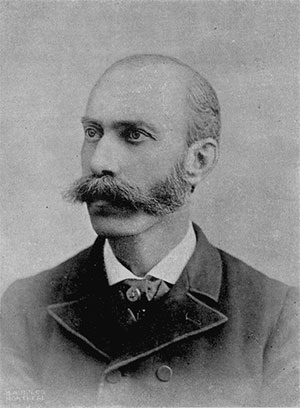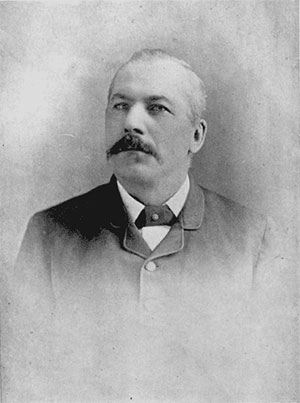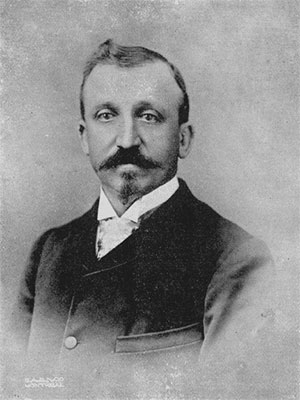Illustrated History of Coins and Tokens relating to Canada
Biographies of the principal Canadian collectors
Robert Wallace McLachlan
Montreal, Canada
The subject of this sketch was born in Hochelaga, an outlying suburb which has since become part of the City of Montreal, in the year 1845. He is of Scottish descent, his father William McLachlan having come from Lochwinnoch, a village of Renfrewshire, Scotland, in 1826; and his mother, Ann Stephen, from near Dufftown in Banffshire in 1834.
He began to collect coins about the year 1857, while yet a boy, having caught the hobby then prevailing among his school fellows. This hobby was taken up in a similar way to stamp collecting among the boys of today. The abundant and ever varying copper circulation of Canada before the coinage of 1870 afforded ample opportunity for such a pursuit. This collecting faculty having thus early germinated, soon showed signs of permanency, as our youth continued on while most of his associates one after another lost interest. There appears to have been some hereditary disposition, for as a reward for his continuity he was given a few coins that had been his father's share of a collection formed by his grandfather. In the course of years these numismatic inclinations began slowly to take shape until 1863, when his collection numbered 350, consisting mainly of such foreign coins as were from time to time picked up in circulation. During this year he became acquainted with Mr. J. L. Bronsdon, at that time the most enthusiastic numismatist in Canada, from whom he received such fresh impetus that before its close his collection lead more than doubled, numbering 750.
Mr. Bronsdon gave much good advice and instructions, turning his disciple from a simple hoarder of odd coppers into paths which has made him a systematic and painstaking student of Numismatology. Among other things he was advised to turn his attention to the Canadian series, which advice was so steadily followed that Mr. McLachlan has formed the most complete collection of Canadian Coins and Medals known.
About that time the Numismatic Society of Montreal was organized, but Mr. McLachlan was believed to be too young for membership, so that it was not until 1855 that he was counted eligible. He at once took a prominent part in its proceedings, which activity he has continued ever since, hardly ever missing a meeting except when absent from the city.
In 1872 the publication of the Canadian Antiquarian was commenced, and Mr. McLachlan was nominated on the editorial staff, and many papers from his pen have appeared in the sixteen volumes that have so far been published; among the more noteworthy may be mentioned; A plea for an artistic coinage Henry VIII Crown. Medals of the war of 1812. The first water pipes laid in Montreal. The Edward Murphy medal, also published in pamphlet form. Cuvillier currency of 1837. Canadian Temperance medals, also as a pamphlet. The Glastonbury penny, as a leaflet. Our rarest Canadian coins, Louisbourg medals, as a pamphlet. Money and medals of Canada under the aid regime, also as a pamphlet. Canadian coins issued in 1892.
In the American journal of Numismatics he published an addenda to Sandham's Coins of Canada and also in the same journal a series of articles on Canadian Coins, which afterwards appeared in book form entitled "Canadian Numismatics." This work gives a better history of the coins and medals so far issued.
He has represented the Numismatic and Antiquarian Society at several of the annual meetings of the Royal Society of Canada, and at one of these meetings read a paper on Annals of the Nova Scotian currency, which paper has been published in the proceedings of the Royal Society and also in pamphlet form.
His Canadian Communion tokens is considered a standard work on the subject.
In 1884 Mr. McLachlan was elected a corresponding member of the American Numismatic and Archeological Society of New York, and sent a paper entitled A Montreal Indian Medal, to be read at its twenty-fifth annual meeting. This paper has appeared in the proceedings of the society.
He was also nominated as a Membre Associe Etranger de la Societe Royale de Numismatique de Belgique, and sent a paper to be read before the Congres International de Numismatique held under the auspices of that society in Brussels in 1891. This paper appeared in the proceedings of the Congres and in pamphlet form.
Mr. McLachlan has also been a member of the Numismatic Society of London, since 1866.
He has ever continued to add to his collection, so that it now numbers over 8,000, being the largest in the Dominion; while it is peculiarly rich in rare Canadians, it is by no means wanting in other departments, as the coinages in all ages and countries are represented. Specimens of the Ancient Greek and Roman series are brought together in large numbers. In the latter only the rare families and Emperors are wanting, while in the English series many tine examples are to be found. The series in Continental Europe, South America and Australia is well advanced.
Mr. McLachlan's forte as a collector does not rest so much in brilliancy and dash, but in steady continuity. His love for the science has continued all along unabated, and now he stands at its head in his native country, being everywhere recognized as an authority.
Adelard J. Boucher
Montreal, Canada
Adelard J. Boucher, founder and first president of the Numismatic Society of Montreal, is a direct descendant, eight generations removed, of Marin Boucher (brother of Gaspard Boucher, the first of the name to settle in Canada, and father of Pierre Boucher the celebrated governor of Three Rivers) who left Langy in the Bishopric of Mortagne (Perche, France) about the beginning of the seventeenth century, to settle on the River St. Charles in Canada. Adelard, who was horn at Maskinonge on the 28th of June, 1835, is the son of the late Dr. F. X. Olivier Boucher and Dame Emelie Munro, and grandson of Lieut. Col. Boucher, seignor of Carufel and Maskinonge, and last survivor (he died in 1861) of the officers of the Regiment of Royal Canadian Volunteers which he joined when very young as ensign in de Bleury's company.
Having at a tender age lost both of his parents, young Boucher was sent by his uncles, Francois, Antoine and Joseph LaRocque, who had charge of his education, to Mount St. Mary's College, a celebrated Catholic Institution in Maryland, United States, where he pursued his studies for six years (I845-50). In 1851 we find him at the Seminary of Issy, in Paris, and the year following at the College de la Providence, under the guidance of the Jesuit Fathers, at Amiens, France. After his return to Canada, for a short time he held a clerkship in the law office of the Hon. Geo. Et. Cartier, and in 1854 he was appointed secretary of the Montreal and Bytown Railway Company.
He married the same year Miss Philomenc Rousseau, and from this union were born fourteen children, of which seven still survive. His oldest son, Francois, a pupil of Prume, the eminent virtuoso violinist, and afterwards of the Royal Conservatory of Music, Liege, Belgium, has become one of our high class artists. He is now established at Peru, Nebraska, where he has charge of the Musical department in the State Normal School, One of Mr. Boucher's daughters (Josephine) took the veil eight years ago at the Hotel Dieu Convent at Montreal, and became in 1888 one of the four foundresses of the new Hotel Dieu at Windsor, Ontario.
In 1855 Mr. Boucher was nominated, by the Honorable L. T. Drummond, secretary to Seignorial Commission, and fulfilled its duties until the winter of 1858. He then undertook to run for the Legislative Assembly, contesting the County of Maskinonge in opposition to Mr. J. B. Eric Dorian, called l'Enfant Terrible, but after several encounters with his adversary he retired from the field in favor of Mr. Caron, who won the election.
Mr. Boucher, with the co-operation of the Oblat Fathers, founded in 1859 the Maitrise St Pierre, which he directed for two years. In faithfully fulfilling his different duties and offices, he always found leisure to devote to the cultivation of Music, for which he had a very strong attachment. Since 1853 Mr. Boucher has filled the position of organist or Choirmaster at St. Patrick's, St Peter's, St. James, the Gesu and St. Jean Baptiste churches. He organized La Societe Ste. Cecile, l'Orpheon Canadien and other musical associations, and the brilliant success of the numerous musical performances given by these societies under his direction, at Montreal and elsewhere, are still fresh in the memory of the habitues of our musical entertainments. Perhaps the most notable of these were given by the choir of the Gesu, which he conducted for twenty years.
At a date comparatively distant, (about forty years ago,) not only was the music trade of this Province extensively in the hands of a few English importing firms, but our art loving French Canadians were tied down to musical publications issued in the United States and in England. Our educational establishments, our choral societies and even our church choirs, were under complete subjection to these Firms. Desiring to remedy this regrettable state of things, Mr. Boucher established in Montreal, in 1861, in partnership with Messrs Laurent & Laforce, the first French Canadian Music Store. Later the firm took the name of Boucher & Manseau. In 1868 he was joined by Mr. Arthur Lavigne, and opened up in the City of Quebec its first French music store, under the name of Boucher & Lavigne. Mr. Boucher, since 1870, has continued the business as sole partner. He has edited successively the following musical art journals; Les Beaux Arts, Le Canada Musical and Le Journal Musical. The success of his business has so long rested on such a solid basis that his increasing clientele is recruited not only from all parts of the Dominion, from every American centre where French Canadians have settled.
A beautiful piece in silver of eight Sueldos, bearing the military bust of Bolivar, which Mr. Boucher received in change while overlooking the de Ramezay Seignory in 1858, struck him particularly on account of its great beauty and its peculiar design. Shortly afterwards a friend, employed like himself, on the Seignorial Commission, sent him several copper coins found in Three Rivers, coins which were often mentioned or described in the official documents that passed through their hands. He was thus the owner of the first Liards, denier tournois and double tournois which were turned up in these later days. About the same time he was indebted to the kindness of an American lady for a silver itzibou of Japan. He needed no further encouragement to fix his attention on this, to Canada, new and interesting source of information. The first Numismatic collection in the country had now began to take shape, and its happy owner, in his ardent desire to learn and systematize this charming subject for study, even now dreamed of organizing a society which could throw light on this science which until then had been altogether unknown in that country.
A coincidence of tastes presently brought about a rapprochement between Mr. Boucher and Mr. Stanley C. Bagg, of Montreal, who also had a most pronounced taste for Antiques, and who already had formed a small collection of Roman and Greek coins.
The proposition to organize a Numismatic Society, which was made to Mr. Bagg, was received with avidity. Mr. Jos. A. Manseau, Mr. Boucher's partner, an ardent book lover and collector, readily accepted the proposition to join the new society. Major L. A. Huguet-Latour, who by his researches has considerably enriched the history of our Province, was the fourth member. It was therefore, by these gentlemen, that on the 9th of December, 1862, the Numismatic Society of Montreal was formed; the first and for thirty years the only one in Canada. It is we believe the third founded in America. The society was not long in attracting to its membership other collectors, among whom we may mention Messrs Joshua L. Bronsdon, James Rattray, Alexander Murray, James Ferrier jr., J. E. Gullbeault, Daniel Rose, Joseph Royal, William Notman and Dr. Hector Pelletier.
In 1866, the association having acquired an increasing taste for Antiquarian study, the majority of members deciding to supplement the ideas of the first founders, altered the name of the society to the more general one of the Numismatic and Antiquarian Society of Montreal," and under this title it continued to prosper until it celebrated with eclat on December 15th, 1887, its silver wedding, under the distinguished patronage of the Marquis of Lansdowne, Governor General of the Dominion.
Mr. Boucher sold by public auction in 1866 the first collection which he had formed, a collection that had been awarded a diploma and a first prize at the Provincial Exhibition of 1863, where it was exhibited. His catalogue contained 726 lots, and the sale, which ran through three evenings, the 22nd, 231d and 24th of February, was conducted by Mr. John J. Arnton. This sale realized about $400, a highly satisfactory amount, notwithstanding that such rare pieces as the Bout de l'Isle tokens and the side view were sold, or rather given away, for so and 35 cents respectively.
This first sale of Mr. Boucher's was followed by that of Mr. James Rattray, in November, 1866, and those of Mr. Win. V, B. Hall and Mr. H. Laggatt (the Bronsdon Collection) in 1867. We do not believe that any other public auction of coins has since taken place in Canada.
In disposing of his collection Mr. Boucher never dreamed of breaking altogether with his favorite study Numismatics for he at once commenced collecting again.
Stimulated by a taste always enlarging, aided by his first experience and also by the enlightened advice of several distinguished foreign Numismatists, among others Mr. E. Zay, of Paris, G. Sambon, of Rome, W. S. Lincoln, of London, and Lyman H. Low, of New-York, he again set courageously to work and has succeeded anew in forming a general collection, which is probably the most complete and varied to be found in the country. The superb Canadian Collections of Messrs. Thomas Wilson and R. W. McLachlan, we know excel that of Mr. Boucher's, but we know of no other cabinet where are to be seen series nearly complete of the regular coinages of the different countries of Europe, Asia, Africa, Oceanica and North and South America. His series of Papal coins is above all remarkable, nearly fifty Popes, elating from the eleventh century, are here well represented, His French, Russian, Helvetian and Mexican series, as well as that of the Prince Bishops, of Liege (a city where Mr. Boucher resided for several months in 1876), are equally interesting.
Mr. Boucher is a Fellow of the Numismatic and Antiquarian Society of Montreal, and a corresponding member of the American Numismatic and Archeological Society of New York.
Gerald E. Hart
Montreal, Canada, Author of The Fall of New France.
Coming of old English Canadian stock (his ancestors being among the earliest settlers in Canada under the English flag), Mr Hart has naturally taken special interest in the history of his native land. He was born in the city of Montreal, Match 26th, 1849. His father, Adolphus M. Hart, was a well-known member of the legal profession. His paternal grandfather, Aaron Hart, was a commissariat officer in the staff of General Amherst, at the time of the conquest of Canada by the English in 1760, finally settling at Three Rivers, and becoming a large landed proprietor in that vicinity. Mr. Hart obtained his earliest schooling in Montreal. The family removing to the United States, he received further tuition at the excellent public schools of New York. Returning to Canada he finished his education at Lawlor's English Academy at Three Rivers. Having been actively engaged in business since leaving school, Mr. Hart has not had much leisure to devote to literature; nevertheless he has written and studied to some purpose. The most of his leisure time, however, has been devoted to society work especially that of the Numismatic and Antiquarian Society of Montreal, of which he was secretary for many years. Mr. Hart had (until its sale at Boston in April 1890), the finest library in Canada of original Canadian works prior to 1820, even surpassing the collection in the Government Library at Ottawa, and having few superiors among the libraries of the United States.
Mr. Hart began collecting coins, while at school. Before coppers were withdrawn from circulation by Sir Francis Hincks, in 1870, Mr. Hart picked out all coins and tokens received by the Witness and the Star every morning, and then obtained a very large number of rare varieties. He formed several collections with these and purchases made in sales in England, Germany and New York. He sold a collection to the Dominion Government in 1880, comprising a great many pieces, all Canadian Coins and medals. This collection he sold to the Government for $2500. He wrote a catalogue descriptive of the collection, which the Government were to publish and give him $500 extra, but they did not do so. He has sold two other fine collections at auction in New York, and still has a very fine one left to regale his pastime. His specialties have been, Canadian, English, French, Greek and Roman, in all of which he possessed unique and valuable varieties, and made many discoveries of rare varieties, some of which are given in this book as the Hart varieties. He is also in possession of one of the best collections of paper-money issued by private parties or banking institutions during the Rebellion of 1837-38. Mr. Hart was one of the earliest members of the Numismatic Society, and is now one of its life members. He claims that Numismatics is a great aid to the study of history, and recommends all historical students to form a collection, even if it be a small one.
Gerald E. Hart
LS. Joseph Casault
Ottawa, Ont., Canada
Mr. Casault was born in St. Thomas de Montmagny on the ninth of May, 1838. In 1857 he was appointed, under recommendation of the late Sir E. P. Tache, its Speaker, to a position in the service of the Legislative Council, then meeting in Toronto. In 1858, he was transferred to the Library of Parliament, which position he still holds. In 1859 Mr. Casault married, in Toronto, his first wife, Miss Lucie-Adeline Rocque, and in 1862 he married, at Quebec, his second wife, Miss Philomene Alain.
From the time of his entry into the government services, Mr. Casault gave much of his attention to the collection of works of Canadian history and literature, but his collection is especially rich in works relating to the different religious controversies in Canada.
Mr. Casault, whose numismatic taste showed itself at a tender age by gathering strange coppers while at school, did not begin collecting until he was 27. His love for numismatics so grew that at the age of 4o he had secured the nucleus of a fine collection, to which he has since continued to add without relaxation.
In 1880 the Ottawa Government purchased the Hart collection, which collection was placed in the centre of the Library, where it now remains under the care of Mr. Casault, who has since continued to improve it as funds were placed to his disposal. Apart from that of the Government, Mr. Casault has the most complete collection in Ottawa, and also one of the best in Upper Canada. Mr. Casault is the highest type of a gentleman, and is highly spoken of among his numismatic confreres of Ottawa and elsewhere.
Thomas Wilson
Clarence, Ont., Canada
Mr. Wilson was born in Montreal on the seventh of December, 1825, and consequently is now 68 years of age.
Mr. Wilson was only seven years old when his family left Montreal for Grenville, Que., where he resided about fifteen years. It was here at the village school that young Thomas pursued his studies. In 1848 the family removed from Grenville to Cumberland in Upper Canada, and several years later he went to Buckingham, in company of one of his brothers, settling finally at Clarence, Ont., where in 1858 be started in business for himself as general merchant. In 1860, he married Miss Pridham of Grenville, who is still living. They have three children, one daughter and two sons. In 1870, Mr. Wilson commenced a collection of Canadian coins, which to-day is perhaps only excelled by one other. Four or five coins are wanting, but taking into consideration the condition of each coin, his collection has no equal. Mr. Wilson retired from business in 1886 in favor of his eldest son, Arthur, and the business has continued to increase under his able management.
Reverend Pere Jos. Michaud, C.S.V.
Montreal, Canada
The Rev. Pere Michaud, born at Kamouraska on the first of April, 1823, is the son of Joseph and Charlotte Michaud, both of Kamouraska. He entered the college at Ste. Anne la Pocatiere in 1838, and ten years later the St. Viateur Brothers at Joliette. In 1852 he was sent by his superior to Victoria, Vancouver Island, where he was ordained priest in 1854; during his stay in that town he directed the building of the Cathedral of Victoria.
In 1868 he accompanied the second detachment of the Pontifical Zouaves to Rome, and was charged by Bishop Bourget to study the plans of St. Peter's at Rome for the cathedral of Montreal. After a sojourn of eighteen months he returned to Montreal, and finished a model in wood which has helped in the designing and building of our St. Peter's Cathedral in Montreal, which was commenced in 1870, and since the death of the architect, Bourgeault, he has constantly supervised its construction and all its works, and for five years he has not left his post for a single instant. The Cathedral is really his work. His capacities have caused him to lie chosen as arbitrator at different times on very important works, and he was one of those chosen to rectify the defective ventilation arrangements of the House of Parliament at Ottawa.
In 1884 the Rev. Pere Michaud began to devote his leisure hours to numismatic study, and it would be well if his example were followed by other religious institutions, for in less than ten years he has succeeded in forming one of the finest collections of coins in the country. It contains a number of great rarities, such as the North West beaver token, the McAuslane, the Ropery and several Bout de L'Isle tokens.
The Rev. Pere Michaud has resided at the Montreal Deaf and Dumb Institute since 1880, and he intends giving his collection to that institution.
Jos. Leroux, M.D.
Montreal, Canada
Doctor Joseph Leroux was born at St. Augustin, in the County of Two Mountains, Province of Quebec, on the ninth of April, 1849 His father, Dieudonne Leroux, and his mother, Domithilde Allaire, were both French Canadians, and, like most early French Canadians, were so happy in their union that they were blessed with a family of twenty-two children, of which nine boys and five girls survive.
It cannot be expected that the subject of this sketch received any special attention in his early years, but his parents, knowing the value of a good education, sent young Joseph to school when five years old, and at twelve he was found competent enough to pursue his own way, dependent on his own resources. When nineteen he entered the Jacques Cartier Normal School in Montreal, and there made such rapid progress that in 1871 he was prepared to undertake the head mastership of a country model school.
In 1873 he married Miss Marie G. Mitchell, but they did not follow the example of his parents, for only two children, a boy now fourteen and a girl of twelve, have appeared as the fruits of their union. In 1877 the Provincial Government conferred on him an Academy Diploma, and the following year he visited Europe to study the different systems of education prevailing on the continent. In 1879 sickness occasioned his return and his relinquishment of the teaching profession; he therefore in the same year took up his studies for the profession of medicine at the Laval University, from which he received the degree of Bachelor in 1881 and that of Doctor of Medicine in 1883.
Dr. Leroux commenced to collect in 1876 and entered into numismatic studies with great fervency. In 1882 he published a catalogue of Canadian coins, in 1883 his Canadian Numismatic Atlas, in 1885 the Collectors Vade Mecum, and in 1886 the Collectionneur, a monthly journal, but his most important work was his Canadian Coin Cabinet, published in 1888, of which a supplement appeared in 1890, and an enlarged and revised edition in 1892. As may thus be seen, Dr. Leroux has earned the thanks of Numismatic Amateurs in making known to them coins and medals by his illustrations, and the importance of collections of this kind.
The encouragement that has been so extensively bestowed on his works has only been his due and few writers have had the advantage of the doctor in being thus rewarded by an ample remuneration through the sale of their works.
Dr. Leroux has continued to zealously practice his profession, and notwithstanding his active interest in numismatics for one or two years past, he has devoted much of his leisure to the study of the calling which has taken up a good part of his life.
F.R.E. Campeau
Ottawa, Ont., Canada
Chevalier Fabien Rene Edouard Campeau is a born collector, for since his childhood he has collected everything collectable that came to his hands insects, minerals, curiosities of all kinds, and, naturally, old coppers and medals. For several years he has discarded other things and confined his attention mainly to Numismatics, and although he collects coins of all nations and ages, he has given particular attention to Canadians, and above all to Canadian medals. He is one of the few collectors that collect each coin, when possible, in duplicate, and his medals are nearly all brilliant proofs. He is an enthusiastic seeker after rarities, and having made numerous discoveries, his collection is exceedingly valuable. He has such a passion for this pursuit that he is inclined to pass the whole of his time collecting, but his numerous other engagements prevent it. The accompanying biography will help to make the reader acquainted with this distinguished Numismatist.
He was born at Quebec on the 8th of July, 1844, and pursued both a commercial and classical course of studies at the College of Levis and at the Quebec Seminary. After the completion of his studies he was employed for a number of years in the lumber and hardware business. In 1871, he left the employ of Chinic Ileaudet, of Quebec, which firm he had served for many years as accountant and cashier, to accept a position under the Minister of the Inland Revenue at Ottawa, which position he still holds.
From this time he has constantly devoted his energies to the public enterprises of the Capital, no matter whether religious or philanthropic, or national or even commercial in their character. In 1878, he founded La Societe tie Secours Mutuels Franco-Canadien, of which he was elected president. Elected as separate school commissioner in 1879, he was nominated to the office of president in 1886. In 1882 he became president of l'Orphelinat Saint-Joseph. In 1883 he was chosen president of branch No. 28 of the Catholic Mutual Benefit Association, of which he in course became Supreme Deputy. The same year, for his devotedness, he was made a Chevalier of the Order of Saint-Sepulchre, and the Huron Indians of Lorette named him Grand Huron Chief under the name (On8e de Ak8endaeriti) "The devout man," a title which has been conferred on no other white man except the Marquis of Lorne. In 1886, he was chosen as general president of the St. Jean-Baptiste society of the Capital, also as president of l'Institut Canadien-Francais. This same year he was named Canadian representative of la Societe des Chevaliers Sauveteurs des Alpes Maritimes, and general delegate of l'Alliance Francaise. The French Government itself accorded him the academical Palms, with the title of Officier d'Academie. In 1887, he was elected a director of la Societe de Colonisation du Lac Temiscamingue, of which society he is now president. During the same year an Indian Rajah sent him the Star of Merit, and later he was named Avocat de St. Pierre. In 1890, he took an active part in organizing a joint stock manufacturing company under the name of the Ottawa Canning Co., (Limited), and became its Vice-President. The crowning honor of his active and meritorious life was his election, in 1893, as municipal councilor for St. George's Ward, Ottawa, a ward in which no French Canadian has ever before been elected. Chevalier Campeau is also an author and a member of several other literary, scientific and philanthropic, foreign as well as home societies. He is corresponding member of the Numismatic and Antiquarian Society of Montreal, and President of the Numismatic Society of Ottawa, of which he was one of the founders.
His arms are a shield, bearing a landscape with a field and lake in the foreground, a cross on the top of a mountain in the distance. Chief azure, a star argent; crest, a Chevalier's Helmet and Visar. Motto: Je laisse dire.
Alfred Desroches
Montreal, Canada
Mr. Alfred Desroches was born at Pointe-aux-Trembles, near Montreal, on the 29th of March 1839, and after he had received a primary education in the model school of his native village, was sent by his parents, at the age of eleven, to the College of l'Assomption. He studied there three years, when he left to enter upon his apprenticeship with Messrs. Boble & Henderey, goldsmiths, now Henderey & Leslie, St. Peter Street. In 1863 he went to Terrebonne to set up in business for himself, where, during the same year, a company of Volunteers, in connection with the 12th Battalion of Lower Canadian Militia, having been organized by the Honorable Edward Masson, he joined this company as a non-commissioned officer. In 1866, he accompanied his battalion to the frontier on the second Fenian raid, when he was three months under arms. In 1868, Mr. Desroches returned to Montreal and re-entered the employ of the old firm with which he has ever since been connected. Mr. Desroches, in 1860, married Miss Julie Gervais, of Pointe-aux-Trembles, his first wife, from which union have sprung four children. In 1874, he married his second wife, Mrs. Philomene Biron, widow of David Boble, a former employer. From this marriage there was only one daughter, who still survives. Mr. Alfred Deroches is a son of Joseph Desroches and Emilie Marion, both of Pointe-aux-Trembles. He is a lineal descendant of one of the first settlers in Montreal. A short account of this ancestor may be highly interesting.
Mr. Jean Desroches arrived in Quebec in 1641, and in 1642 formed part of Maisonneuve's escort to Montreal. The first marriage celebrated at Ville-Marie, on the 18th of November, 1647, was that of this same Jean Desroches, of the Parish of Ste. Lucie, near Autun, with Francoise Code, of the Parish of St. Martin-Dige, whose father and mother were citizens of Montreal. He secured a concession of land in 1650, which land and houses erected thereon, belonging to Jean Desroches, are shown on the Plan of Ville-Marie given by Abbe Faillon in 1672. This land was situated near the corner of Notre Dame and Saint Francois-Xavier streets. Another of his farms is still known under the name of Ruisseau Desroches at Pointe-aux-Trembles, Jean Desroches distinguished himself in several encounters with Indians in and around Montreal.
Mr. Alfred Desroches, with one of his brothers, Joseph, have all the marriage contracts, deeds of concession and other authentic documents showing that they are the only direct descendants of Jean Desroches, possessing positive proofs of their pretensions. Mr. Alfred Desroches, desiring to know the history of his country, believed he could not better secure this end than by studying its coins, thus we find him in 1881 deep in Numismatic study, and working without relaxation to form a collection of coins, which eventually became one of the richest in Canada. In 1891, he sold his collection to Mr. P. N. Breton for a good price, and at once set about forming a second collection with the duplicates left after the sale, and this collection he sold in 1892 to the same party, and as Mr. Desroches has wisely invested the funds from these sales, and thus increased his savings, he finds today that his numismatic inclinations have not only secured for himself a knowledge of his country's history but also considerable means, and, like his ancestors, he has won the respect of his fellow citizens.
F.X. Paquet
Ottawa, Ont., Canada
Mr. F. X. Paquet was born at Quebec on the 12th of January, 1845, but most of his youth was passed at St. Jean-Port-Joli. In 1859, he was sent to the college at Ste. Anne la Pocatiete, where he remained six years. In 1865, he commenced to study for the Notarial profession under T. Michaud, notary public, Registrar of the County of I' Islet at St-Jean-Port-Joli. In 1869, he relinquished his notarial studies to accept an appointment as general agent and telegrapher on the Grand Trunk, the Levis and Kennebec, and the Quebec, Montreal, Ottawa and Occidental Railways, which positions he held from 1869 to 1882.
Mr. Paquet commenced to collect insects in 1876, and minerals in 1880. He was appointed in 1883, by the, minister of public works, as draughts man in the chief architect's office at Ottawa, which position he now holds. The same year he was commissioned to illuminate an address, presented by the City of Ottawa to Princess Louise, on her return from Bermuda, and in 1887, he illuminated on satin the address presented by the St. Jean Baptiste Society of Ottawa to Her Majesty Queen Victoria, on attaining her Jubilee. Mr. Paquet excels in painting in water colors on satin, vellum, paper, etc., besides he has executed many original designs in pen and ink, among which are a large number of the pieces represented in this book. He commenced a collection of stamps in 1883 which numbered 3500 varieties, and which he sold in 1891, to confine all his leisure time to coins and medals in general, but more particularly those of Canada. He at once threw himself with ardor into the work, and by means of exchanges he soon became possessed of a considerable collection which secured several prizes and medals at the last exhibition at Ottawa, held in September. Elected Secretary of the Numismatic Society of Ottawa, in 1891, he continues to hold the position, as well as that of Superintendent of exchanges.

